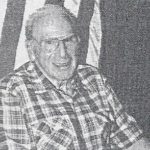By Regina Villiers. Originally published July 26, 2000 in The Suburban Life, added July 16, 2018.

Ralph Covert served in the U.S. Navy, 1944-46.
Ralph Covert of Madeira is a World War II veteran of the U.S. Navy in the South Pacific. He served aboard a cargo ship, the USS Almaack, for two years, 1944-46. He was at Leyte, Luzon, Iwo Jima – all place names never to be forgotten in American history.
When he went into the Navy, he had been living in Oakley, working at the Milling Machine. His first job there had been to make airplane propellers.
In the Navy, he became a carpenter’s mate 3/c. “I could make and repair anything,” he said. He still can.
Men who served in the Navy never forget their ships as long as they live. Their ships were their homes away from home. Ralph has not forgotten his.
The Almaack was a veteran carrier for ammunitions and assault troops who went ashore on days of invasion. She had her sternest test in the invasion of Luzon on Jan. 9, 1945. She had already gone 90,000 miles, nearly four times around the earth, into 39 harbors from Casablanca to the Philippines.
At the invasion of Luzon, the Almaack had already participated in the invasions of Guam, Saipan and Leyte.
For the Lingayen operation, the Almaack loaded the ammunition, stores and vehicles at a rear base. The 300 enlisted men and 45 officers aboard the ship had a life and death interest in the success of this mission.
At the rehearsal area, the Almaack joined the invasion fleet and steamed into enemy waters. Friendly forces held Leyte and Mindoro, but along the route lay many Japanese-held islands.
The passage through Surigao Strait and Mindanao Sea was uneventful, but at sundown on Jan. 6, Japanese planes attacked the formation, only to be shot down.
On the morning of Jan. 8, in the South China Sea, two Japanese bombers slipped past the combat air patrol. One straddled the Almaack with two bombs, which did not explode. Repeated attacks kept the Almaack’s crew at general quarters until long after dark, but only one enemy plane got through to crash another ship. One Japanese plane was shot down in the center of the operation.
On the morning of Jan. 9, the formation entered the Lingayen Gulf with small escort ships going ahead. Before dawn, in the transport area, the Almaack lowered her boats. Heavy antiaircraft fire destroyed three enemy planes.
Before 8 a.m., all boats were in the water and away to their assigned ships to carry troops and tanks in the assault waves. Bombardment of the beach began at 9 a.m. Soon after, the first wave hit the beach. An hour later, the Almaack’s beach unloading group landed and the shop moved to an inner berth two and a half miles off Lingayen City.
The Almaack stayed in the gulf for three and a half days for unloading. It was delayed by heavy surf. Morning and evening, a smoke screen was laid around the anchored fleet and the Japanese would send in their planes. The nights, which should have been sheltering, were not because the Japanese torpedo boats were active.
The Almaack’s boats had a tough going on the beaches. The landing craft broached in the surf. The boat crews worked to repair holes in the hulls and to clear cargo nets and debris that fouled the propellers. The Almaack lost four LCVP’s and one LCM in the surf.
And the difficulties of the beach party with the surf were equaled by their battle with mosquitos in the rice paddies. One officer, after spending the night in a deep foxhole, counted 45 swollen bites on his face in the morning.
Hundreds of Filipinos came down out of the hills to help unload the small boats. They told the Americans how Japanese had confiscated their rice crops causing starving conditions. Most were so emaciated that they could only carry light loads.
On the afternoon of Jan. 12, the unloading was completed. Boats were swung aboard and the last of the small ships was fueled and watered.
The voyage back to Leyte was accomplished safely despite a determined Kamikaze attack on the convoy. There were also threatened night attacks by motor torpedo boats.
After he left the Navy in 1946, Ralph Covert returned to the Cincinnati area to pick up his life.
He moved to Madeira in 1950, where he has lived ever since, at the corner of Marvin and Naomi.
He has always liked to hunt and fish. For a long time, he and his wife owned a place in Florida. He no longer has it, but he misses it. He still likes to travel and to see far places in the world. They took a trip to Alaska this summer.
Ralph covert leads a more peaceful life now. That’s fine with him. But almost 60 years later, he still remembers life aboard the Almaack, his ship.

Veteran Ralph Covert has lived in Madeira since 1950.